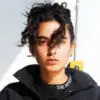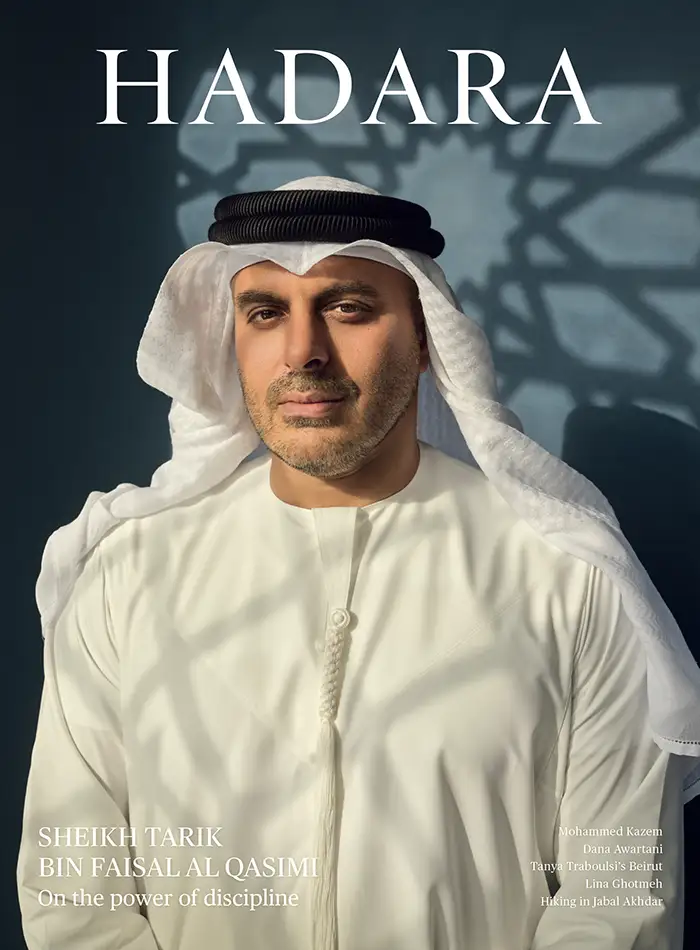Colour My World
Abstract expressionist Samia Halaby will have a retrospective of more than 200 works in Sharjah Art Museum this autumn. The artist takes us inside her studio and her practice.
By Catherine Mazy
Samia Halaby is a towering figure in art, collected by major museums around the world. She is also a tireless activist and historian for Palestine, the homeland she was forced to flee in 1948, when she was 11. She not only broke barriers in the male-dominated domain of abstract expressionism, but also in academia, becoming the first female associate professor at the Yale School of Art in 1972. And she is a pioneer of digital art.
“Samia Halaby occupies an important position in the realm of transnational abstraction—one that is not bounded by geography or a single influence. Hers is a unique voice in global modernism that combines a distinctive technique with an awareness of international art movements, Islamic geometry, as well as an astute sensitivity to the environment around her,” says Sultan Sooud Al Qassemi, founder of the Barjeel Art Foundation in Sharjah. Its collection includes two paintings from the 1960s, a silkscreen print from the 1980s, and a set of her kinetic works from the 1980s and 1990s.

FAN (1966), above, Oil on canvas. Halaby’s evolution is evident through her five-plus decades of work. This early work shows the influence of cubism. Opening image, A ROSE (1987) Oil on canvas. In the 1980s, more freedom appeared in her brushstrokes and shapes. Her compositions’ previous sharp edges turn messy and exuberant. All images courtesy of Samia A. Halaby.
Whereas the early abstract expressionists were notable for their spontaneity, favouring emotions and dismissing structured composition, Halaby (who also taught at the University of Hawaii, Indiana University, The Cooper Union, University of Michigan and Kansas City Art Institute) works with academic rigour, mixing maths, geometry and the science of colour.
“Halaby introduces a level of calculation and planning in her works,” says Alya Mohamed Al Mulla, curator of Sharjah Art Museum. “Abstract expressionism as a movement is not defined by a single style or approach, but by a shared emphasis on individual expression and non-representational art. Halaby incorporated her interests and expertise into the broader framework of abstract expressionism, contributing to the range of styles and techniques within the movement.”
Her subjects often come from nature. “My art is not about my feelings or self-expression. It’s about the world outside there and its beauty,” Halaby says. But she puts nature through her filter of intellectual reordering. Fern (1976), looks like a set of straight lines, slightly tilted left. But the painting’s measurements and changes in tonality are copied from an actual fern leaf.
“My affair with mathematical ideas in my painting is a strong love affair,” she says. “Mathematics is in our language, as Arabs. There’s a love of rhythm and pattern. Sometimes I say, ‘This is too much.’ So on occasion I will break loose and scribble freely. Sometimes I start with a scribble and it gets precise.”
“My art is not about my feelings or self-expression. It’s about the world outside there and its beauty,”

Samia Halaby in her studio.
One can see Halaby’s evolution through her five-plus decades of work. Fan (1966) gives Cubist vibes. Two Diagonals (1968, and in the Barjeel Art Foundation’s collection) is from her Geometric Still Life period. By the time of Fire (1975), Halaby was creating an illusion not only of three dimensions but also of movement. She was also using more colours, as in Rainbow Spirals (1973). In the 1980s, her previous sharp edges turn messy and exuberant, as in Tribeca (1982), A Rose (1987) and Turn and Grow (1987).
“I see abstraction emanating historically from the Arabs as pure abstraction. And I see it related to nature and reality. In my current work, I try to make it clear that my abstraction looks at nature in the Arab way and in the materialist way. I’m trying to see what principles
I can extract and apply to the artwork.”
In 1986, when she was 50 years old, Halaby acquired an Amiga 1000, an early personal computer that supported many colours. “I was saying, ‘Samia, if you’re an artist of your time, why are you using oil paint? That’s 400 years old, that’s not a technology of my time.’
I thought, ‘I’m going to have to have the courage to do it.’ I bought a computer only for making art. I didn’t buy it for anything else. At that time, there wasn’t much else anyhow.”
In Bird Dog (1987), black triangles replicate across a patterned mauve background, accentuated by maroon rectangles and, finally, yellow triangles. In Yafa (1991), neon-coloured geometric shapes grow and jostle across the screen. The works, what she calls kinetic paintings, repeat on a loop, like gifs.

RAINBOW SPIRALS (1973) Oil on canvas. In the early 1970s, Halaby introduces the illusion of three dimensions and movement. She works with academic rigour, greatly influenced by geometry and the science of colour.
“I found it’s much like painting,” she says of her digital art. “I do a little bit of programming. I run it. Do I like it? Yes, I continue. If I don’t like it, I erase it and change it. It’s back and forth.”
By the 1990s, Halaby’s titles include many references to nature—Lemon Blossoms of Palestine (1996), Green Hay (1999)—and she is using thick brushstrokes, short and long, daubed without the clear geometric forms. Raucous colours give her paintings a new energy.
“Colour is a magnificent tool to manipulate when you’re an abstract painter. When you’re an illusionist painter, you’re limited by how you use colour,” Halaby says. “Colour becomes a local surface and you can shade it. There’s incredible science to how to shade it properly. How one colour relates to another without shading is a whole new science that is part of abstraction.”
With those paintings in the 1990s, Halaby “started questioning the meaning of the rectangle in our lives and in painting, especially. My education being Western centric, I learned the idea that the surface of the picture, which we call the picture plane, is essentially a window into the world and we see the world through it. This is an idea that has thousands of years of history. I thought, ‘OK, I am an upstart painter. Why am I painting on a window?’”
“Colour is a magnificent tool to manipulate when you’re an abstract painter. When you’re an illusionist painter, you’re limited by how you use colour.”

WET WINDY AUTUMN (2009) By the 1990s, she is using thick brushstrokes, short and long, daubed without clear geometric forms. Raucous colours give her paintings a new energy.
She began cutting up painted canvases and putting the shapes on the wall, then stitching them to be hung. “I didn’t want to make sculpture that sat on the ground,” she says. “If I hang a piece, it becomes a new kind of reality that I can make grow from all directions. So I started thinking of space underwater.” Eventually, Halaby reconciled with the rectangle. “I said, ‘Samia, you’re an idiot. The rectangle has been part of our history since the very beginning, from the clay tablet.’”
The joy of her more recent paintings contrasts with the sombre yet defiant subjects of some of her book projects during the same period.
Halaby was born in Jerusalem in 1936, and her family had to flee in 1948 in the Nakba, moving to Beirut and then to Cincinnati, Ohio. She has been an outspoken activist all her life about the injustice of the Palestinians’ plight. With her 2017 book, Drawing the Kafr Qasem Massacre, she documents the 1956 massacre by Israeli soldiers of 49 Arab villagers at Kafr Qasem as they came home from working in the fields. The dead included 18 children.
Halaby interviewed survivors at Kafr Qasem. Almost like a police portrait artist, she sketched what they told her. Unsuspecting quarry workers return home on their bicycles after a long day of labour. Halaby documents who was killed, who was wounded, who survived. A huddle of women—their names and ages noted—fell as they were shot. Only one escaped. Survivors and descendants have not been allowed to honour the dead. They have only Halaby’s book and her art, in this case not abstract at all, to console them.




